For Honor: light strategy and heavy swords in a medieval dueler
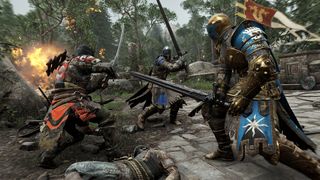
For Honor is a medieval sword combat game built around one very basic principle: armored knights and their man-sized longswords are lumbering forces of destruction, and every swipe, thrust and parry should feel heavy. In the best moments of the two matches of For Honor I got the chance to play at E3, I ran up behind another human opponent, heaved my longsword up above my head, and brought it crashing down onto their head, chopping off a huge chunk of their health bar. For Honor is a game that presents opportunities for those moments constantly, if you have a good team at your back.
The structure of the mode I played in a pair of 4-on-4 matches is classic zone control: three capture points are spread across a small castle courtyard, and standing within the vicinity of the capture point for a few seconds (when no enemies are nearby) gives it to your team, earning you 150 points. Those points are temporary: the enemy can easily recapture the point from you, taking away the 150 and adding it to their own ledger.
In the middle of the map, dozens of AI soldiers for each team rush at each other in a medieval mix of Dynasty Warriors and MOBA lanes. They’re weak, nonthreatening fodder for human players, but they keep the middle area contested until one team wades in and cuts down 20 or 30 enemy soldiers.
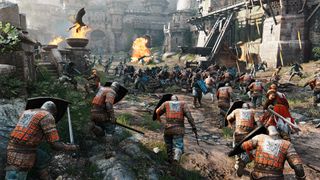
Kills earn permanent points, and once a team’s point total bubbles over 1000, the enemy team is sent into retreat; at that point, anyone who dies on the retreating team won’t respawn. Killing them all secures a win; to recover from a retreat, the team in danger must recapture a control point to drop their opponents’ score down below 1000. It’s a lightly tactical game, with your only real decision being which control point to run to at any given time.
Capturing a control point that the enemy team owns takes a mere three or four seconds, meaning there’s very little ability to counter enemy movements. In my two matches, there was a whole lot of running between control points as soon as they were taken and springing after enemy knights to run them down (and then run them through). After only a couple matches I was left hoping that the full game offers the chance for more complex strategies, as the back-and-forth rush between points on such a small map feels like it would wear thin quickly. Then again, there’s quite possibly nuance to For Honor’s strategy that I didn’t pick up in 30 minutes.
I did pick up the nuance in the sword combat, which was mostly about very big knights swinging very heavy swords into other very big knights very very hard. On the DualShock 4, holding down the left trigger enters into a combat stance, and the right bumper and trigger deliver light and heavy strikes. The depth and joy of the combat comes from positioning those strikes from the left, right, or above: each attack direction is telegraphed by a knight’s body language, and holding your own sword in the same orientation will deliver a sword-clanging block.
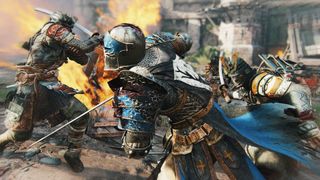
It sounds easy, but in the heat of combat it was appropriately hard to read enemy attacks, and I often found myself switching stances too quickly—anticipating my own strike—and whiffing a block. But every one-on-one fight I got into was a lively jumble of mad swinging, satisfying parries and what-direction-will-they-pick head games. The game definitely thrives in these intense back-and-forths, and wildly swinging against a decent opponent is a good way to end up dead quick.
The biggest gaming news, reviews and hardware deals
Keep up to date with the most important stories and the best deals, as picked by the PC Gamer team.
If either team bands together for superior teamwork, though, that delicate balance quickly goes out the window. In two-on-one battles, it’s easy to wreck an enemy knight by wildly hammering on the attack button as fast as you can. When you’re coming up from behind, it’s easy to land a brutal heavy attack that lops off a third of your enemy’s health. And even if they can see you coming, it’s all but impossible to block two opponents at once. If you’re outnumbered, you’re dead.
Ganging up on enemy players is still really fun, but I couldn’t help notice that most of the combat’s depth went out the window in those situations. Maybe a pair of evenly matched, equally coordinated teams will bring that depth back in unequal encounters; maybe some of the game’s more advanced techniques like parrying (countering a strike with your own at the last second, as parries typically work) give skilled players a fighting chance against two opponents.
I want to know how much more there is to For Honor below the surface—whether there are other modes, or weapons, and how different maps will introduce new strategies—but I’m pretty sold on the combat’s heft and heat-of-the-moment tension.
I played For Honor on PS4, and that seems to be the platform Ubisoft plans to use for the game's upcoming beta. No word on when the game will be available, but it is confirmed for PC.

Wes has been covering games and hardware for more than 10 years, first at tech sites like The Wirecutter and Tested before joining the PC Gamer team in 2014. Wes plays a little bit of everything, but he'll always jump at the chance to cover emulation and Japanese games.
When he's not obsessively optimizing and re-optimizing a tangle of conveyor belts in Satisfactory (it's really becoming a problem), he's probably playing a 20-year-old Final Fantasy or some opaque ASCII roguelike. With a focus on writing and editing features, he seeks out personal stories and in-depth histories from the corners of PC gaming and its niche communities. 50% pizza by volume (deep dish, to be specific).
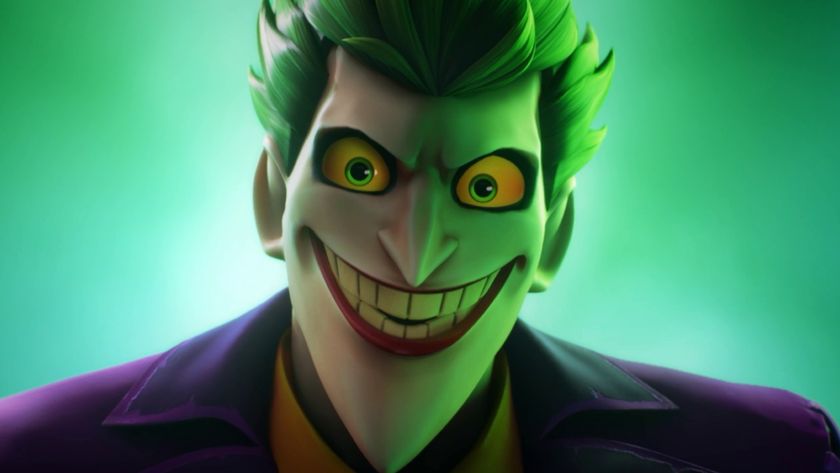
MultiVersus is somehow using its dying breath to go full looney tunes and put out what may be one of its best patches, and now fans want it to be saved
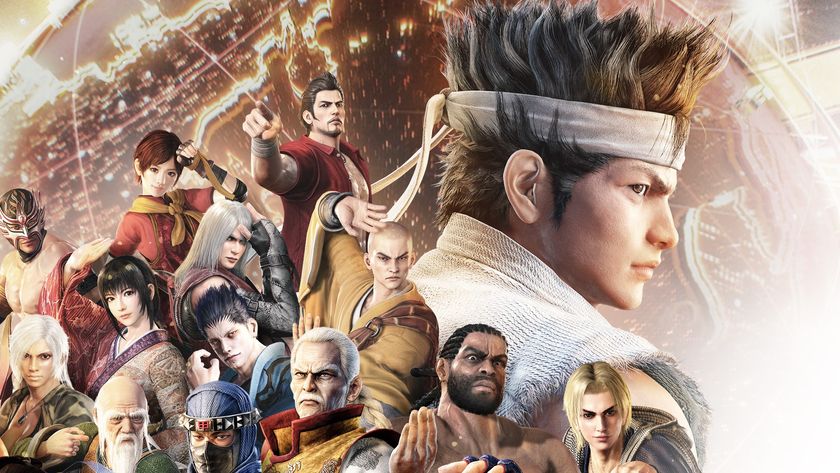
Virtua Fighter 5 R.E.V.O. isn't just a PC port of a 19-year-old game: it's the reason a diehard fighting game community can 'finally reach out and play with each other across the world'
Most Popular






